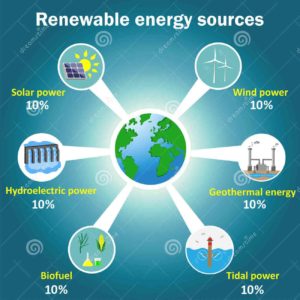Over the last 200 years an ever-increasing proportion of our energy has come from non-renewable sources such as oil and coal. While demand for energy rises these resources are running out and scientists are exploring the potential of renewable sources of energy for the future.

Renewable and non-renewable energy resources All life on earth is sustained by energy from the sun. Plants and animals can store energy and some of this energy remains with them when they die. It is the remains of these ancient animals and plants that make up fossil fuels. Fossil fuels are non-renewable because they will run out one day. Burning fossil fuels generates greenhouse gases and relying on them for energy generation is unsustainable. Hence the need to find more renewable, sustainable ways of generating energy. Renewable or infinite energy resources are sources of power that quickly replenish themselves and can be used again and again. Some resources can be thought of as both renewable and non-renewable.
-
Wood can be used for fuel and is renewable if trees are replanted.
-
Biomass, which is material from living things, can be renewable if plants are replanted.
Non-renewable energy resources
Watch below table in a Wide Screen mode for a mobile option.
Type of fuel
|
Where it is from
|
Advantages
|
Disadvantag
Coal (fossil fuel)
-
Formed from fossilised plants and consisting of carbon with various organic and some inorganic compounds.
-
Mined from seams of coal, found sandwiched between layers of rock in the earth.
-
Burnt to provide heat or electricity.
Oil (fossil fuel)
-
A carbon-based liquid formed from fossilized animals.
-
Lakes of oil are sandwiched between seams of rock in the earth.
-
Pipes are sunk down to the reservoirs to pump the oil out.
-
Widely used in industry and transport.
Natural gas (fossil fuel)
-
Methane and some other gases trapped between seams of rock under the earth's surface.
-
Pipes are sunk into the ground to release the gas.
-
Often used in houses for heating and cooking.
-
Gas is a ready-made fuel.
-
It is a relatively cheap form of energy.
-
It's a slightly cleaner fuel than coal and oil.
-
When burned, it gives off atmospheric pollutants, including greenhouse gases.
-
Only limited supply of gas.
Nuclear
-
A small amount of radioactive material produces a lot of energy.
-
Raw materials are relatively cheap and can last quite a long time.
-
It doesn't give off atmospheric pollutants.
-
Nuclear reactors are expensive to run.
-
Nuclear waste is highly toxic, and needs to be safely stored for hundreds or thousands of years (storage is extremely expensive).
-
Leakage of nuclear materials can have a devastating impact on people and the environment. The worst nuclear reactor accident was at Chernobyl, Ukraine in 1986.
Biomass
-
Biomass energy is generated from decaying plant or animal waste.
-
It can also be an organic material which is burned to provide energy, eg heat, or electricity.
-
An example of biomass energy is oilseed rape (yellow flowers you see in the UK in summer), which produces oil.
-
After treatment with chemicals it can be used as a fuel in diesel engines.
-
It is a cheap and readily available source of energy.
-
If the crops are replaced, biomass can be a long-term, sustainable energy source.
-
When burned, it gives off atmospheric pollutants, including greenhouse gases. If crops are not replanted, biomass is a non-renewable resource.
Wood
-
A cheap and readily available source of energy.
-
If the trees are replaced, wood burning can be a long-term, sustainable energy source.
-
When burned it gives off atmospheric pollutants, including greenhouse gases.
-
If trees are not replanted wood is a non-renewable resource.
es
|
|
|
|
|
|
|
|
|
|
|
|
|
|
|
|
|
|
|
|
|
|
|
|
|
How long will fossil fuels last? Estimates from international organizations suggest that if the world’s demand for
energy from fossil fuels continues at the present rate that oil and gas reserves may run out within some of our lifetimes. Coal is expected to last longer. Estimated length of time left for fossil fuels
Fossil fuel
|
Time left
|
Oil
|
50 years
|
Natural gas
|
70 years
|
Coal
|
250 years
|
